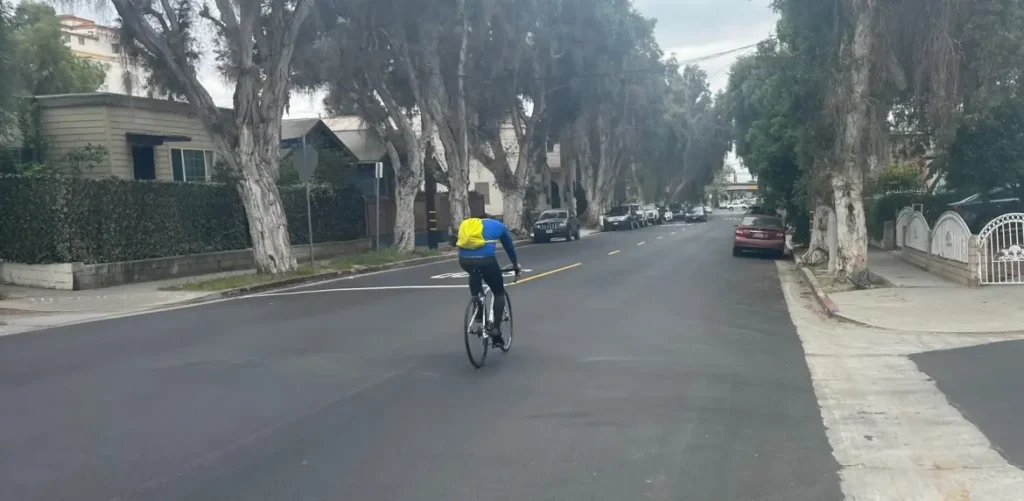A couple months after L.A. City voters overwhelmingly demanded safer streets via Measure HLA, the city appears to be installing fewer safety upgrades than before the vote. Last week, the city repaved what appears to be the first test case for the new law: Coronado Street.
HLA Improvements Appear to Be on Hold
Measure HLA – the Healthy Streets L.A. initiative – mandates that the city gradually implement the city’s bus/bike/walk improvements plan (called Mobility Plan 2035 – approved in 2015) whenever the city resurfaces street segments one-eighth of a mile or longer.
HLA officially became city law on April 9. Now, over a month in, how has the city responded?
The city has done nothing. New resurfacing has yet to trigger mobility improvements.
There are even indications that the city is now doing less than its past, inadequate Mobility Plan implementation, pausing repaving work on streets that would get upgrades.
According to StreetsLA’s Resurfacing Work Completed online listing (which shows most, but not quite all, city repaving), the city has completed 60+ repaving projects since HLA took effect. Comparing these to MP2035, none of them trigger HLA-required upgrades. It’s expected that a majority of resurfaced street segments would not trigger HLA upgrades; lots of repaving is done on smaller neighborhood streets not upgraded in MP2035. Looking at 2024 resurfacing completed prior to April 9, SBLA estimates that one street in roughly 20 to 30 would have triggered HLA-required upgrades, so zero in 60 appears suspicious.
Two city sources unwilling to speak on record shared with Streetsblog that the Public Works Department Bureau of Street Services (StreetsLA) has apparently placed all MP2035 bike/bus/walk street segments “on hold” for city departments to determine if and where HLA improvements would be installed.
Last week, Streetsblog requested confirmation of the apparent hold from the main departments involved: StreetsLA and the Transportation Department (LADOT). Neither department responded to that Streetsblog question at press time.
(StreetsLA is generally responsible for the physical asphalt condition of the street, plus ADA access. LADOT is generally responsible for the striping, specifying how many lanes and how wide they are – for through lanes, turn lanes, bike lanes, car parking, etc.)
In theory, a brief pause might not be a bad thing at this point. City departments might be working to finalize designs for longer or more strategic repaving. (But then again, city inaction led to the need for HLA, and several city department leaders were openly hostile to HLA in the lead-up to its election.)
It’s difficult to tell what’s going on, because the city (no departmental leadership, nor Mayor Karen Bass, nor individual City Councilmembers) hasn’t made any sort of post-approval statement regarding HLA, neither to the public nor responding to press inquiries.
Historically, StreetsLA and LADOT have often coordinated repaving with implementation of new and improved facilities for walking, bicycling, and transit. These successful departmental collaborations are numerous. Some have been great; most were modest. A few include: Venice Boulevard bus/bike/walk improvements, San Vicente protected bike lanes, the recent BLAST program (traffic circles and bikeways), Lincoln Park Avenue lanes (resurfaced prior to HLA, striping finished after HLA), and many others.
Under HLA, StreetsLA and LADOT are basically now required to ramp up those past successes, collaborating on every MP2035 repaving.
Where will the first HLA-era success story be located? Keep your eyes peeled (and let Streetsblog L.A. know if you think you might have spotted repaving that could trigger improvements – please email to tips@la.streetsblog.org.)
National Boulevard
It appeared that National Boulevard might be the first street to trigger HLA upgrades. Spoiler: it didn’t.
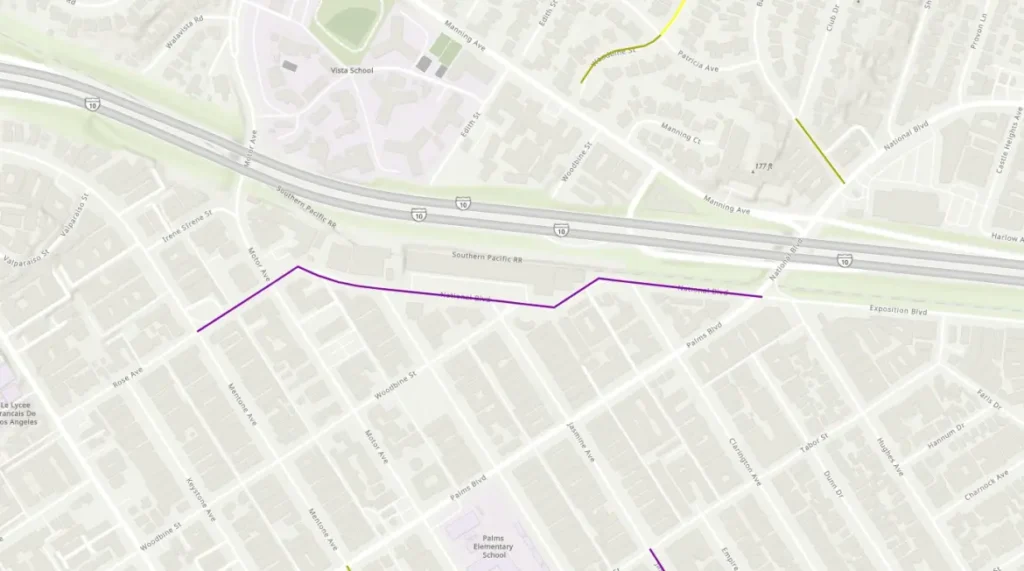
StreetsLA’s online repaving map shows, for Fiscal Year 2023-24, a planned half-mile repaving of National from Palms Boulevard to Mentone Avenue – just west of the Metro E Line Palms Station. MP2035 designated this street to receive bikeway upgrades: existing unprotected bike lanes would become protected lanes. (MP2035 also designates this part of National as a Pedestrian Enhanced District, and the city did install new sidewalks where there had been a gap.)
Starting in late April, StreetsLA repaved parts of National Boulevard, but instead of the full half-mile, the repaving project was only about a tenth of a mile (between Woodbine Street and Clarington Avenue), short of the 1/8-mile trigger.
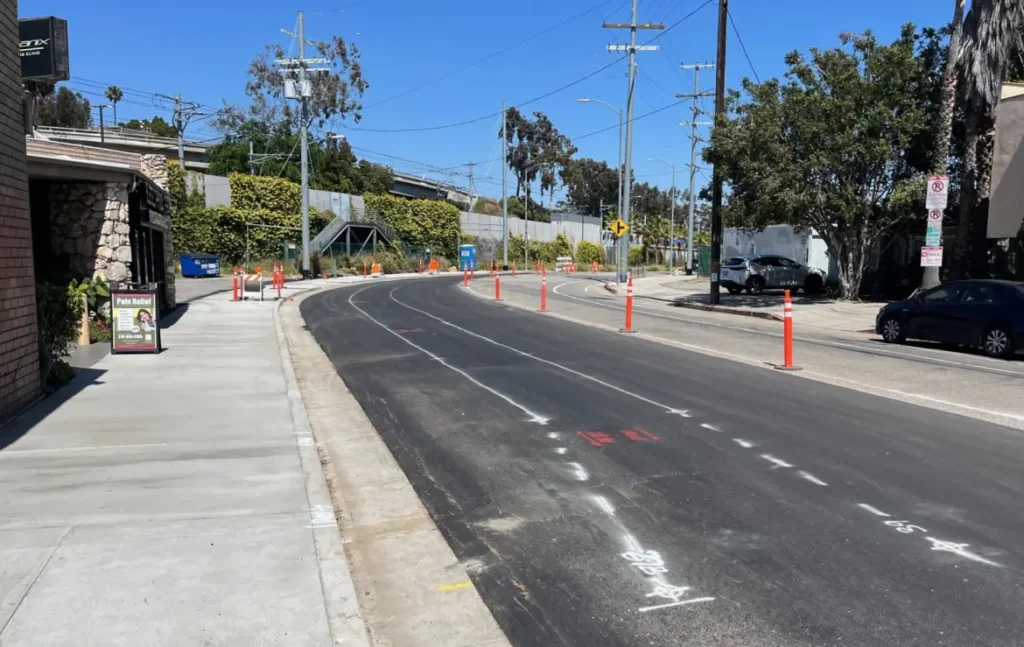
For that part of National, the city reinstalled the existing unprotected bike lanes.
Coronado Street
A couple who lives nearby tipped off Streetsblog that the city repaved parts of Coronado Street last week. The repaving omitted city-approved protected bike lanes there, but Coronado does appear to be the first street where city repaving really should have triggered HLA requirements.
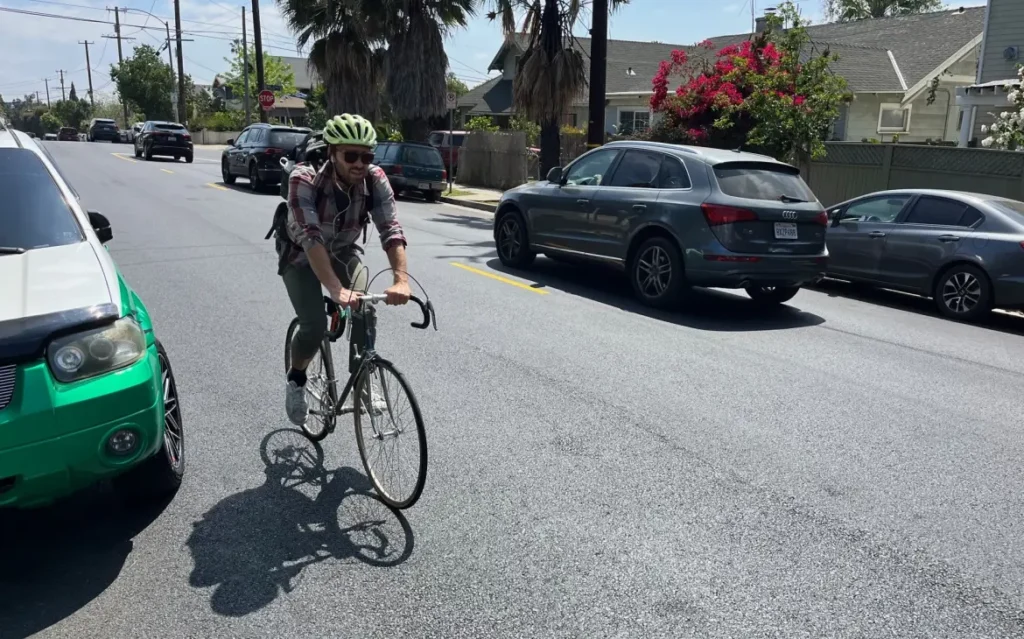
Coronado Street is located in central Los Angeles, in the neighborhoods of Echo Park, Silver Lake, and Westlake. Coronado is a smaller street that sees a lot of bicycling as it is relatively flat in a hilly area, and one of the least trafficked area streets that crosses (under) the 101 Freeway.
Last week’s repaving is a third of a mile long (exceeding the one-eighth mile HLA trigger) from Bellevue Avenue to Sunset Boulevard.
At the time, the city also repaved a short stretch of Coronado below Temple Avenue, and part of Temple (both have bikeways approved in MP2035).
One wrinkle on Coronado is that the repaving does not appear to be part of the city’s main Department of Public Works StreetsLA repaving program (the above-mentioned PPP), but resulted from a Department of Water and Power project. Measure HLA does apply to all city repaving, regardless of which department does the work.
LADWP is wrapping up more that a year of construction on its Coronado Trunk Line project.
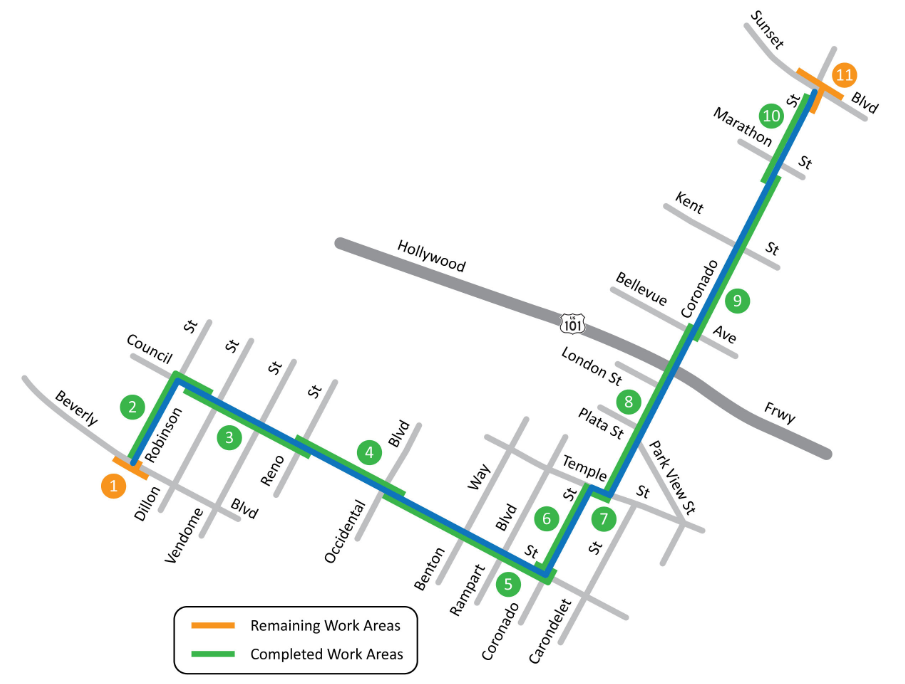
The Coronado Trunk Line project specifics (its environmental clearance) were approved in 2019 – four years after the city approved protected bike lanes on Coronado. If Los Angeles took bicyclist safety more seriously, street resurfacing during multi-million dollar infrastructure projects like Coronado (and Metro construction and new development) would be opportunities to implement approved plans.
The city’s past decades of routinely failing to install approved bikeways points to why safe streets advocates resorted to a ballot measure to force the city’s hand. Even with a new voter-approved legally binding requirement, it appears that the city failed again last week.
